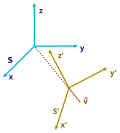Celestial mechanics
Celestial mechanics is a part of astronomy that looks at the movement of the objects in the sky, and tries to find models to describe and explain these movements. The objects described include stars and planets, and also comets, and other similar objects.
The mathematics of celestial mechanics include spherical geometry, trigonometry and Newton's laws of motion.
History
The first known examples of celestial mechanics are from Mesopotamia, around 3000 BC. The Venus tablet of Ammisaduqa is a record of observations about the planet Venus. The tablet also describes the finding that solar and lunar eclipses are periodic events.
About the same time, ancient Egyptians found the length of the solar year to be 365.25 days. In Europe, this figure was in used until the Gregorian calendar was introduced in the 16th century.
At the same time, Eratosthenes worked out that the radius of the Earth was 252.000 stadia, or 50 times the distance between Alexandria and Aswan. This value is 41,750 kilometres (25,940 mi). It is very close to the real value of
Celestial Mechanics Media
An inertial frame of reference (brown) mapped from a baseline coordinate system (blue)
40,075 kilometres (24,901 mi) at the equator.
In the 2nd century BC, Hipparchus calculated the distance between the Earth and the Moon to be 30 times the diameter of the Earth. This value is also very close to the modern one.
In the 17th century, Johannes Kepler observed the motion of planets in the sky. He created three laws of planetary motion that described their orbits.


